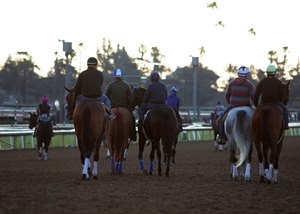Negotiations Continue Over New Stronach Group Rules


Following meetings that lasted late into the evening March 15, representatives of The Stronach Group and the Thoroughbred Owners of California are continuing ongoing discussions about Salix (commonly known as Lasix). Race-day administration of that medication appears to be a primary obstacle to resuming racing at Santa Anita Park.
Originally, Santa Anita announced a tentative date—March 22—to begin racing again after shutting down for more than two weeks to examine the racing surface. There have been 22 breakdowns at Santa Anita since the current meet opened Dec. 26.
Belinda Stronach of TSG sent an open letter March 14 announcing new house rules that, among other things, would ban race-day medication. Lasix is the lone race-day medication permitted in California.
Under California law, racetracks and the horsemen's associations are required to have an agreement in place before an immediate ban on Lasix could go into place. Because TSG and TOC could not come to a resolution on the issue, Santa Anita will not resume racing March 22.
"To make these regulatory changes that we've announced, we have to have cooperation and an agreement," said Tim Ritvo, chief operating officer of TSG. "We are negotiating about how to implement these changes. As long as we're in agreement with the TOC, the process is a lot easier."
If TSG and TOC come to an agreement, "we could go right to work," said Ritvo. "If not, we would have to request a 10-day hearing from the (California Horse Racing Board)."
Ritvo said the CHRB would schedule the hearing after the 10-day notice and then the two sides "would debate those issues."
Both Ritvo and Greg Avioli, president and CEO of TOC, said ongoing meetings have been cordial.
"I'm actually optimistic that we're going to get something done," said Avioli.
"It all comes down to Lasix because, pretty much, I would say we're in agreement on everything else," said Ritvo. "And understandably because this is a very scary thing because generations of horses have run on Lasix."
Horsemen have expressed concerns about implementing a Lasix ban immediately. They have asked for clarification about details of the ban, such as whether it would include training.
"One thing we do know, and we've talked with The Stronach Group about, is what happens to horses who don't run on Lasix once you change treatment prior to a race," said Avioli. "Many horses, without Lasix, are not given any liquid, in some cases any food, 24 hours before a race. That's troubling. What are going to be the measures with regards to that?"
Ritvo said Santa Anita's house rules are designed to be compliant with the International Federation of Horseracing Authorities, which bans all race-day medication.
The TOC and other horsemen have noted that Lasix has not been linked to breakdowns.
"There's no linkage—they're two different issues," said Avioli.
Ritvo said Belinda Stronach "is steadfast about the health and welfare of the horse." He noted that people have advised Stronach that Lasix has not contributed to the breakdowns. However, TSG wants its house rules to reflect "the standards of the rest of the world," explained Ritvo.
"I think, in the end, the horsemen and track management want what's in the best interest of the horse," said Ritvo. "Sometimes we disagree about how we get there and how fast we get there."
Avioli said that TOC sees the Lasix situation as "a breed issue." He said that TOC has suggested linking the timing of a Lasix removal to foal crop "to give breeders some time to adjust their breeding decisions." He said that 90% of horses today have run on Lasix and/or both of their parents did.
"If you ban Lasix tomorrow, what does that do economically?" Avioli asked. "How does that impact a horse that won the Kentucky Derby on Lasix?"
TSG has also put Golden Gate Fields entries on hold, pending the outcome of the negotiations. Golden Gate is scheduled to run March 16-17 and then have three normal dark days before resuming racing March 21.
Santa Anita has published a condition book with a March 22 racing resumption date. Ritvo said that, depending on how quickly TSG and TOC can come to an agreement, Santa Anita could either use that condition book or write a new one.
While Ritvo was speaking with the press, Billy Koch of Little Red Feather Racing asked Ritvo's advice about whether owners should continue to wait for racing at Santa Anita or send their horses elsewhere.
"I would probably give it a few more days and hopefully it will work out," Ritvo replied. "I would wait to see how the negotiations go." He acknowledged the difficulty for owners. "It's not easy to say that when you're paying the bills."
Koch said later that the situation is frustrating because of "the air of uncertainty." He said that Little Red Feather is primarily based in California and he and his clients don't want to leave.
Meanwhile, both Del Mar and Los Alamitos officials have said that those two tracks would continue to operate under current California Horse Racing Board rules, which allow the administration of Lasix on race day.
According to a press release issued March 15 by Los Alamitos: "Ed Allred, the owner of Los Alamitos Race Course and a major Quarter Horse owner and breeder on a national basis, said on Friday that Lasix will continue to be allowed at the current year-round Los Alamitos Quarter Horse Racing Association meeting as well as during the upcoming Los Alamitos Racing Association Summer Thoroughbred Meet opening on Thursday, June 27."
Joe Harper, chief executive officer of the Del Mar Thoroughbred Club, confirmed March 16 that the Lasix policy would remain the same at that track, "pending any kind of negotiation going on between Santa Anita and the horsemen."
